Traditional plant-based soap scenting relies on techniques perfected over centuries. You'll achieve the best results by adding essential oils at temperatures below 120°F, using approximately 1% of your total soap weight. Herbal infusions offer authentic fragrance alternatives—simply steep dried plants like lavender or rosemary in carrier oils before adding to your base. Cold process preserves scents better during curing, while hot process allows for post-saponification additions. These time-tested methods will transform your homemade soaps into aromatic treasures worth savoring.
Historical Plant-Based Scenting Techniques
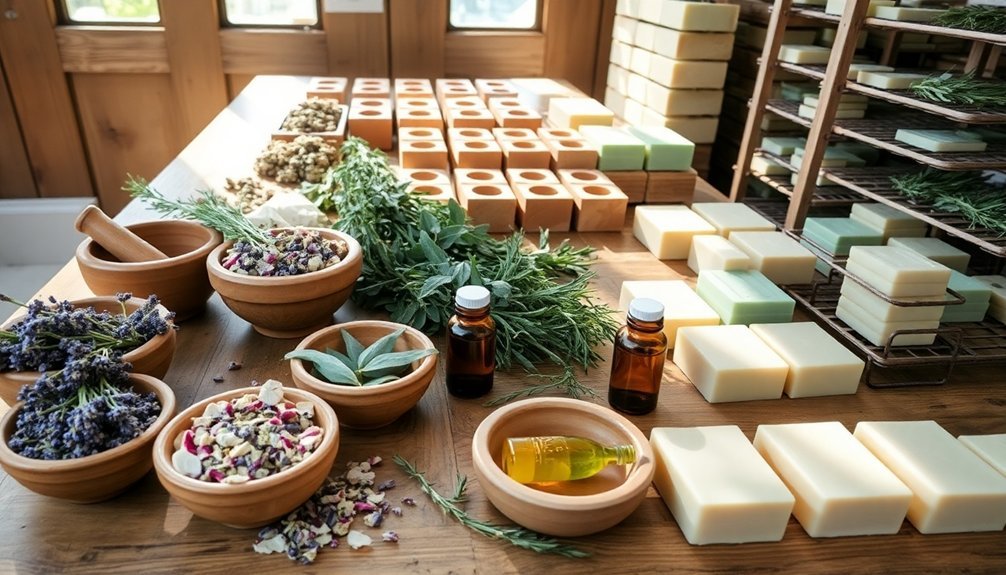
While modern soap production often relies on synthetic fragrances, traditional soap makers developed ingenious methods to incorporate natural scents. You'll find that ancient civilizations like the Egyptians and Romans pioneered the use of aromatic oils from myrrh and frankincense, precursors to today's essential oils.
Soap artisans would boil fragrant plants—lavender, rosemary, and chamomile—with fats during the melting stage, naturally infusing their creations with distinctive aromas. This practice varied by region, with recipes featuring locally available botanicals that reflected cultural preferences.
The traditional saponification process combined animal fats with wood ashes, allowing craftspeople to integrate natural scents before the mixture solidified. Unlike modern fragrance oils, these plant-derived aromatics served dual purposes, both perfuming and enhancing the therapeutic properties of the final soap product.
Essential Oils in Traditional Soap Making
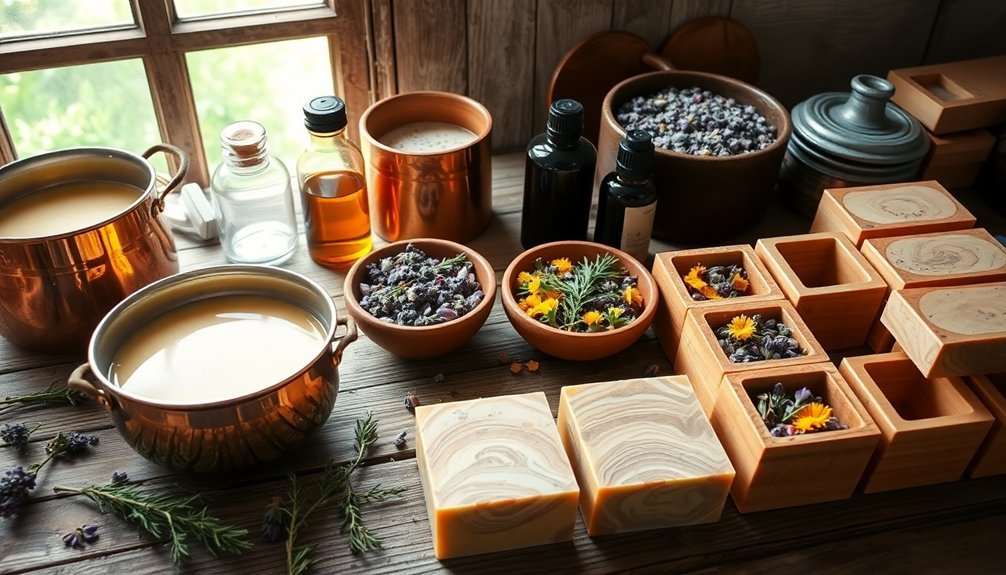
You'll find that historical essential oil blends often combined floral, citrus, and woody notes to create complex, layered aromas in traditional soaps.
When applying these oils to your soap base, you'll need to introduce them at temperatures below 120°F to preserve their therapeutic qualities and scent profiles.
Traditional techniques include adding oils at trace during cold process soap making or incorporating them into melted bases for melt-and-pour methods, allowing you to customize the intensity based on your preference.
Historical Essential Oil Blends
Throughout history, ancient soap artisans mastered the delicate craft of blending essential oils, transforming simple cleansing products into aromatic treasures with therapeutic benefits.
You'll find that Egyptians and Romans deliberately selected oils like lavender and rosemary not just for their pleasing scents, but for their powerful antibacterial properties that enhanced soap quality.
These historical blends weren't random combinations—they reflected regional plant availability and cultural traditions.
Soap makers extracted these precious oils through steam distillation or cold pressing of botanical materials, capturing concentrated fragrances from citrus peels and mint leaves.
They carefully added these blends during the mixing stage of soap making to guarantee the fragrances would survive saponification.
This timing was critical for creating products with the long-lasting aromas that distinguished quality soaps from basic cleansers.
Oil Application Techniques
The art of applying essential oils in soap making extends beyond merely knowing which fragrances to select. You'll achieve the best results by incorporating natural essential oils at just 1% of your total soap weight, balancing scent without irritating skin.
| Technique | Benefit |
|---|---|
| Heating to 120°F | Improves oil binding with soap base |
| Blending oils | Creates unique fragrance profiles |
| Pre-production testing | Guarantees scent longevity in final product |
| Graduated addition | Prevents overpowering aromas |
When working with essential oils, remember they behave differently during saponification. Some remain strong while others fade quickly. Before committing to a full batch, conduct small tests to evaluate how your chosen oils perform. This approach saves you from disappointing results and helps you master the delicate balance between subtle and overpowering scents.
Herbal Infusions for Natural Fragrance
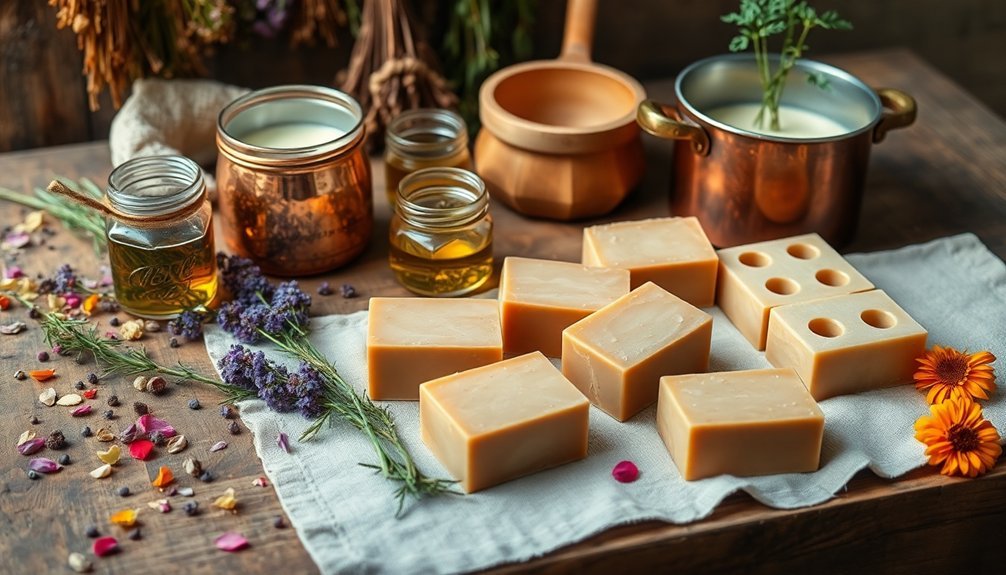
While synthetic fragrances dominate commercial soap production, herbal infusions offer a more authentic and natural alternative for scenting handmade soaps.
You'll create these herbal infusions by steeping dried plants in a carrier oil—typically olive or coconut—for several weeks, allowing the oil to extract the plants' aromatic compounds.
Lavender, chamomile, and rosemary are excellent choices for natural soap making, each contributing unique therapeutic and sensory qualities.
When incorporating these infused oils into your recipe, aim for 10-20% of your total oil content to achieve ideal scent retention without compromising the soap's quality.
Before adding your herbal infusions to your soap base, be sure to strain them thoroughly.
This prevents plant material from creating an uneven texture in your final product, ensuring your natural soap has both beautiful fragrance and professional appearance.
Dried Botanicals and Their Aromatic Properties
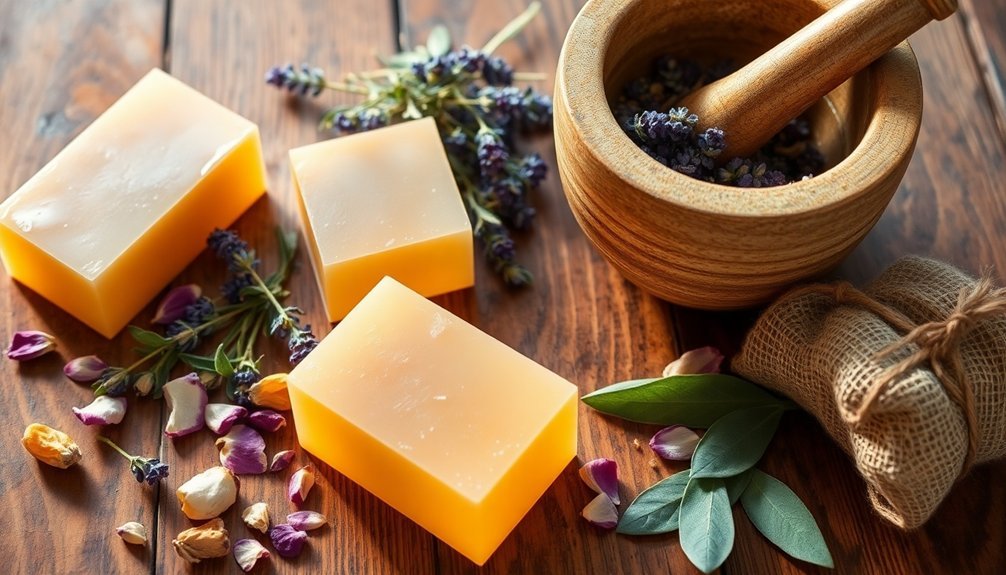
Many dried botanicals offer exceptional aromatic properties that go beyond just creating pleasant scents in your handmade soaps. When you incorporate lavender, chamomile, or rose petals into your soap-making process, you're not only adding fragrance but also beneficial properties for the skin.
- Extract aromatic compounds through cold oil infusion or by boiling with fats to seamlessly blend fragrances.
- Choose calendula or chamomile for sensitive skin formulations due to their soothing properties.
- Consider the plant material's freshness and storage conditions to maximize scent intensity and longevity.
- Incorporate dried botanicals both for their therapeutic qualities and to create visually appealing, artisanal products that attract customers.
The effectiveness of botanical scents depends largely on your extraction method and the quality of your dried plant materials.
Cold vs. Hot Process Scenting Considerations
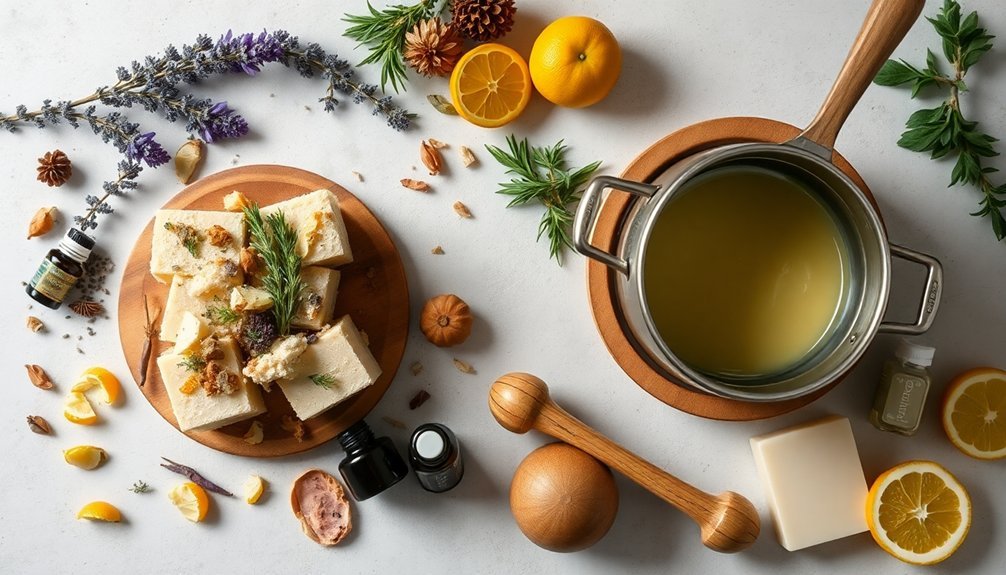
When crafting plant-based soaps, you'll notice cold process methods typically preserve essential oil scents better, allowing fragrances to mature during the longer cure time.
The temperature at which you add aromatic oils greatly impacts their stability—hot process soaping requires careful monitoring to prevent scent degradation at higher heat points.
Your botanical additives will behave differently in each method, with delicate plant compounds maintaining more integrity in cold process, while hot process offers quicker completion but may sacrifice some of the nuanced fragrance notes.
Scent Retention Differences
Because temperature plays an essential role in preserving essential oil properties, cold process soap typically offers enhanced scent retention compared to hot process methods.
You'll notice that essential oils maintain their aromatic integrity better when added at light trace in cold process soap, as they aren't subjected to excessive heat that causes evaporation.
To maximize scent retention in your handcrafted soaps:
- Limit essential oil usage to 3 ounces per gallon regardless of method
- Add essential oils at light trace during cold process for optimal preservation
- Consider adding fragrance oils post-saponification in hot process to boost scent strength
- Blend complementary essential oils in cold process for a more balanced, lasting aroma
The timing of essential oil addition greatly impacts the final scent profile, making cold process the preferred choice for sophisticated botanical fragrances.
Temperature Impact Analysis
The temperature at which you introduce essential oils fundamentally determines their performance in your finished soap.
In cold process soaping, you'll achieve ideal results by adding your essential oils at 100-110°F, preserving their delicate aromatic compounds. This cooler temperature integration allows scents to develop complexity during the curing phase.
Conversely, when working with hot process soap, you'll want to wait until after saponification completes before adding essential oils. Adding them too early at high temperatures can dramatically reduce their potency.
For both methods, temperature management is vital—never exceed 120°F in cold process mixing, and allow hot process soap to cool somewhat before scenting.
While hot process methods permit higher essential oil concentrations due to immediate heat application, cold process techniques offer the advantage of a gradual scent maturation that many soap makers prefer.
Botanical Stability Factors
Understanding botanical stability factors can greatly influence your choice between cold and hot process soap making methods. Cold process soap preserves delicate essential oils more effectively, allowing their aromatic compounds to remain intact throughout the curing period.
- Cold process incorporates essential oils at trace, maximizing scent retention compared to hot process where heat can cause volatility.
- The 4-6 week curing time in cold process allows fragrances to mature and develop depth.
- Lighter citrus oils show remarkably better stability in cold process techniques.
- Essential oil selection should consider evaporation rates—heavier oils like patchouli maintain their presence in both methods while bergamot requires cold process care.
When working with plant-based scents, you'll find cold process offers superior botanical stability for creating richly fragrant, naturally scented soaps.
Blending Plant Essences for Signature Scents
Creating your own signature scents through blending plant essences allows you to craft unique soap fragrances while harnessing the natural benefits of botanical sources.
When experimenting with essential oils, you'll discover how different combinations can enhance your soap making experience, offering anti-bacterial and anti-fungal properties alongside delightful aromas.
Remember to maintain proper dosage—approximately 1% of your total soap base, or one gram of essential oil per 100 grams of base.
Be aware that some oils, particularly citrus varieties, may fade during saponification. Test your blends for longevity and adjust ratios accordingly to preserve your desired scent profile.
You'll also benefit from observing current market trends when selecting plant essences, helping you create seasonal fragrances that resonate with your target audience.
Seasonal Availability of Natural Scenting Materials
While you perfect your signature blends, nature's own calendar plays a significant role in what scents you'll have at your fingertips throughout the year.
Soap makers who understand seasonal harvesting cycles can plan their production more effectively, ensuring the freshest and most potent ingredients.
- Winter/Early Spring – Prime time for citrus essential oils when fruits are at peak ripeness
- Spring/Summer – Floral abundance allows for diverse scent profiles including lavender and rose
- Fall – Spice-forward scents become available, perfect for creating seasonal limited editions
- Year-round planning – Essential oils from rare plants command premium prices, requiring strategic purchasing
Preserving Fragrance Longevity in Plant-Based Soaps
The lingering aroma of your handcrafted soap depends largely on how you incorporate and maintain its natural scents. For ideal results, add essential oils during the melting phase at a maximum of three ounces per gallon. This guarantees thorough integration and stronger scent retention.
Source high-quality essential oils, as their purity directly impacts how long your soap's fragrance will last. You'll find that experimenting with oil combinations creates unique scent profiles that often last longer than single-note fragrances.
Don't rush the cure time – those several weeks of patience allow your soap to develop its full aromatic potential. This significant resting period stabilizes the fragrance compounds, preventing premature scent fading when your beautiful bars finally reach the shower.
Frequently Asked Questions
How to Make Soap Scent Last Longer?
To make your soap scent last longer, use essential oils at three ounces per gallon, add fixatives like resins, guarantee proper curing time, choose high-quality oils like patchouli, and store in cool, dark places.
Does Plant Based Soap Expire?
Yes, your plant-based soap does expire. It typically lasts 1-3 years depending on ingredients. Watch for off smells, discoloration, or texture changes. Keep it dry and store in cool, dark places to maximize lifespan.
What Are the Traditional Soap Making Techniques?
You'll find traditional soap making involves cold process (mixing oils with lye, then curing), hot process (applying heat to speed saponification), and old-fashioned lye creation from wood ashes. Each technique requires patience and careful measurement.
How to Scent Soap Naturally?
You can scent soap naturally using essential oils at 1% concentration or by infusing fragrant herbs into your oils during melting. Always test combinations first, as natural scents may fade and some oils cause skin irritation.
In Summary
You've now explored the rich traditions of plant-based soap scenting, from ancient methods to practical applications. As you create your own aromatic soaps, you'll find that nature's fragrance palette offers endless possibilities. Whether you're infusing oils, adding dried botanicals, or blending unique scent profiles, you're participating in a timeless craft. Remember, patience and experimentation are your allies in developing soaps with lasting botanical fragrances.





Leave a Reply